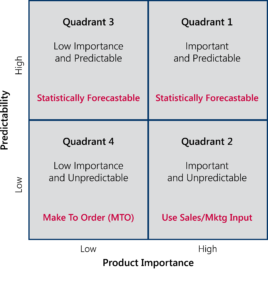Some time ago, I had been trying to help a business improve its statistical forecasting. We tried different parameters and different forecasting algorithms but the statistical forecast for about half of the products could not be improved no matter what we tried. We decided to do a deep dive to understand the reason.
Our team ran some analysis on the data. It took us a few days to go through the analysis. Once we completed the analysis, we found that about half of the product lines were not statistically forecastable, so we developed a set of recommendations for forecasting those products.
The analysis approach we carried out was called Differentiated Forecast Strategy (DFS). This approach is a recommended best practice and every business should perform this analysis to determine which products are appropriate for statistical forecasting and which are not. The Differentiated Forecast Strategy provides a framework that balances the use of statistics for forecastable products; and the use of sales/marketing input and other approaches for products with high variability. Implementation of DFS in the planning system utilizes a combination of statistics, sales input, and naïve forecasts.
Here are the key features of the Differentiated Forecast Strategy:
- It simplifies and improves the work of forecasting.
- It identifies the use of statistical forecasting when product forecast is predictable.
- The importance of the product to the business guides the level of effort used to generate the forecast.
- Ask for sales input only when it is needed so that the Sales Organization can focus primarily on selling.
- Use simple forecasting methods to handle the less important, highly variable products.
Importance criteria can be defined by the business to include revenue, volume growth, market growth potential, and variable margin. The calculation of predictability is determined using Coefficient of Variation (CoV) analysis. A 2×2 matrix is created based on Predictability and Product Importance to represent the four quadrants. Quadrants 1 and 3 represent the predictable products that are statistically forecastable, whereas less predictable ones are handled as shown in Quadrants 2 and 4.

Following are recommended high-level steps for the execution of the DFS Process:
- First, begin with data gathering which is a time-consuming task.
- It is advisable to ask the help of a statistical forecasting expert who can guide and lead the analysis process. The analysis needs to produce 2 key parameters – Coefficient of Variation (CoV) and forecast error. The CoV is an indicator of the product’s predictability or Statistical Forecastability.
- The business needs to determine the criteria for Product Importance, e.g., revenue, volume growth, and profit, to name a few – whatever criteria is important to analyze the business impact.
- Using Predictability and Product Importance, develop a 2×2 matrix representing “Product Importance” and “Predictability” as dimensions.
- Products that are Predictable or below a certain CoV threshold, should be a candidate for statistical forecasting.
- Products that are less predictable but are of high importance are a candidate for sales and marketing input. The Sales and Marketing team should draw upon their market and customer knowledge to get a handle on the demand variability and predict the demand. It is generally advisable for the sales team to forecast about 3 to 4 months into the future and the marketing team from 4th to the 12th month into the future.
- Products that are less predictable and are also of less importance (Quadrant 4) should not be forecasted. One can use several strategies for these groups of products. One strategy could be to make these Make-to-Order (MTO) products. Another option is to use the Min-Max strategy where you make these products only when it hits a Reorder Point, and when it does, make only ‘order up to level’. One can also assess the effectiveness of Naïve forecasting approach for these groups of products.
- Another suggestion for selecting a forecasting method is to compare any forecasting method against the Naïve forecasting method. If any method does not perform better than the Naïve forecasting approach, then use the Naïve forecasting approach.
- Analyze overall business impact due to improved forecasting.
- Evaluate the planning and forecasting impact on products by quadrant, e.g., how to handle Make-to-Order products in Quadrant 4.
- Periodically evaluate “Product Importance” and “Predictability” as the products go through their lifecycles where the Importance and Predictability evolve over time.
Learn More: Differentiated Forecast Strategy Whitepaper
Running a DFS analysis is a highly recommended exercise prior to any demand planning implementation. After implementing this approach we received the following benefits:
- We clearly identified which products are bringing the most value to the business.
- Demand forecasting is segmented based on the value to the business and its statistical predictability.
- Differentially managing the forecasting process gets the enterprise focused on products that are of critical importance to the business.
- Benefits of forecast accuracy become visible to the business through inventory reduction and improved customer service.
- Ensures the right product at the right place at the right time in the right quantities which is the baseline requirement for perfect order fulfillment.
- Reduces the requirement on Sales Organization to provide forecasting input – Critical few vs. Trivial many.
Enjoyed this post? Subscribe or follow Arkieva on Linkedin, Twitter, and Facebook for blog updates.





